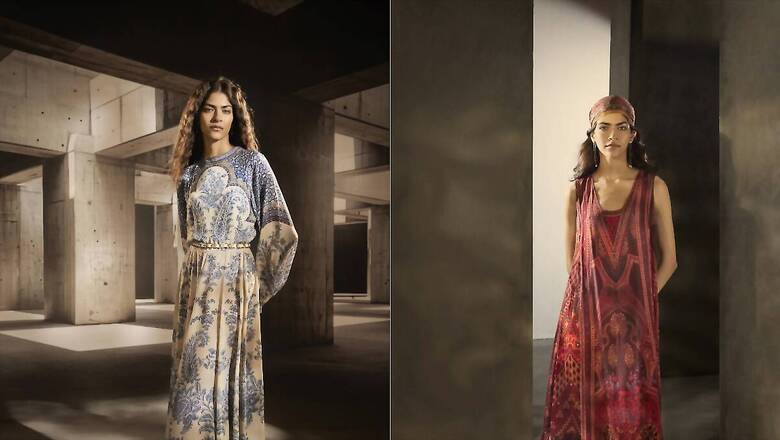
views
In recent years, Indian fabrics have woven their way into the heart of Western fashion, infusing it with a vibrant blend of color, texture, and cultural richness. Renowned for their intricate designs and luxurious feel, these fabrics are now playing a pivotal role in redefining Western clothing, making it more eclectic, stylish, and sustainable.
The Vibrancy of Color
Designer Ritu Kumar says, “Indian fabrics like silk, cotton, and chiffon are celebrated for their rich, vibrant colors. These fabrics bring a lively energy to Western outfits, transforming simple silhouettes into eye-catching ensembles. Whether it’s a bold silk scarf draped over a classic blazer or a cotton blouse with intricate patterns, the infusion of Indian hues adds a fresh, colorful dimension to Western wardrobes.”
Intricate Patterns
Patterns are another hallmark of Indian fabrics. “From paisleys and florals to geometric designs, these intricate patterns are being skillfully integrated into Western fashion. A simple Western dress, when adorned with Indian block prints or Ikat patterns, gains a unique visual appeal, standing out in a sea of monotone attire,” believes Kumar.
Luxurious Textures
Kumar feels the tactile experience of Indian fabrics like silk, velvet, and heavily embroidered textiles cannot be overstated. These materials add a layer of luxury to Western clothing, elevating everyday outfits to something extraordinary. “A velvet jacket or a silk blouse with delicate embroidery becomes a statement piece, reflecting the wearer’s taste for opulence,” adds Kumar.
Cultural Fusion
The blend of Indian and Western styles is leading to a new wave of fusion fashion. Designers are marrying the traditional with the contemporary, creating clothing that resonates across cultures. This fusion results in unique and stylish outfits, such as a Western-style dress made from Bandhani fabric or a pair of jeans embellished with Indian embroidery.
A Push for Sustainable Fashion
With the growing emphasis on sustainability in fashion, Indian fabrics like organic cotton, hemp, and recycled materials are gaining popularity in the West. These eco-friendly textiles not only contribute to a greener planet but also promote ethical fashion choices, making them a favorite among conscious consumers.
Statement Pieces
One of the most exciting ways Indian fabrics are being incorporated into Western fashion is through statement pieces. “Scarves, shawls, and dupattas made from these vibrant materials are becoming essential accessories, adding a touch of elegance and sophistication to Western outfits. These pieces are versatile and can effortlessly transform a simple outfit into something extraordinary,” shares Kumar.
The Rise of Bohemian Chic
The bohemian chic style, characterized by flowy maxi dresses .and skirts, is heavily influenced by Indian fabrics. The fluidity of these materials, combined with traditional Indian prints and patterns, perfectly complements the free-spirited, relaxed vibe of bohemian fashion. This fusion of styles has become a staple in Western fashion, appealing to those who seek both comfort and style.
Popular Indian Fabrics in Western Fashion
Some of the most sought-after Indian fabrics in Western fashion include:
- Silk
- Cotton
- Chiffon
- Velvet
- Embroidered fabrics
- Block-printed fabrics
- Ikat fabrics
- Bandhani fabrics
Designers at the Forefront
Designers are at the forefront of this cultural and sartorial exchange. They are incorporating Indian fabrics into Western clothing in various innovative ways:
- Scarves and Shawls: Perfect for adding a splash of color to any outfit.
- Statement Dresses and Tops: Featuring Indian prints and patterns for a bold look.
- Embellished Denim and Jackets: Infusing casual wear with Indian artistry.
- Colorful Skirts and Pants: Bringing traditional Indian fabrics into contemporary cuts.
- Fusion Clothing: Seamlessly blending Indian and Western styles for a modern twist.
The integration of Indian fabrics into Western fashion is not just a trend but a testament to the timeless beauty and versatility of these textiles. As designers continue to explore this cultural synergy, the possibilities for innovation in fashion are endless, promising a future where East meets West in the most stylish ways.



















Comments
0 comment